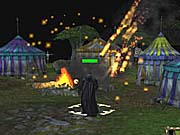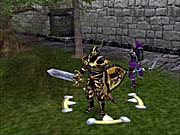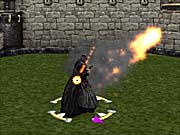Legion: Legend of Excalibur Preview
Venture to the world of Camelot with Midway's strategy RPG for the PlayStation 2. We go hands-on with this medieval romp to deliver you all the details.
Considering how engrossing the events surrounding Camelot, the Knights of the Round Table, and the legendary sword known as Excalibur are, it's surprising that a video game based upon this time period has yet to make the console rounds. One might think that this engrossing story of betrayal, love, and honor would find a suitable home in the adventure genre, but 7-Studios has instead decided to flesh out these happenings in the form of a strategy RPG.

Set in the fifth century, Legion: Legend of Excalibur makes use of the same characters that are found in the popular folklore surrounding King Arthur, but the events have been altered to suit 7 Studios' developmental ambitions. You begin play as Arthur, a lowly page whose half sister, Morgan Le Fay, has murdered his father. Le Fay, a powerful sorceress in her own right, has enlisted the services of three knights to mount an attack on Arthur's territories. After pulling the legendary Excalibur blade from a stone and staking his claim as king, Arthur sets off to defeat the three knights, discover Camelot, and ultimately impose some sort of retribution upon Le Fay. Popular characters such as Sir Galahad, Sir Lancelot, Nimne (the lady of the lake), and Merlin become playable allies throughout the game and offer insight into the missions or enemies at hand. Mythical locations such as Avalon also make an appearance in Legion, enlivening the game with the legend's mystique.
Swordsmen, mages, clerics, and archers are all at your disposal. You may control only one at a time, but four may be in your party at once. Switching characters is as easy as pressing the corresponding shoulder button. Pressing the same button again lets you scroll through a list of commands. Though Eric Yeo of Command & Conquer fame is part of the development team, Legion's real-time strategy elements are streamlined. You can instruct your allies to attack, guard, or flee, but it's impossible to set a character's armies up on one side of a level and take up the offensive somewhere else with the main character. Even so, commanding them to protect you while you dish out punishment can often mean the difference between completing a level and having to try again. Controlling any of your four party members is fairly simple. The X button triggers the light slash attack, and timing your slashes with the flash of your blade results in combos that can deplete your enemies' hit points rather quickly. The square button is your character's heavy attack, and it provides quite a bit of range and effectiveness when compared to the traditional slash. Special moves come in the form of elaborate spells, and they are performed by pressing both the X and square buttons at the same time. Using the heavy and special attacks costs your character mana. Mana replenishes itself with time, so managing your attacks carefully infuses planning and strategy into the game.

Hordes of bots will follow your characters around the levels, attacking any enemies you come into contact with. Not far into the game, you discover Camelot and the Knights of the Roundtable. Once knights have been obtained, you may select your party members before heading into battle. Characters are rated in five characteristics: hit points, attack, defense, mana points, and category. The category rating increases the strategy involved in Legion considerably. Using a knight with an ice rating, such as Sir Lancelot, makes defeating enemies with fire attributes much easier. Medieval projectile weapons, such as the catapult, the ballista, and the trebuchet, are scattered throughout the levels, and once you breach the last protective line of enemies, they fall under your control. You can control some projectile weapons manually, while others fire on the enemy automatically. As you progress through the game you are awarded with attribute points that are automatically dispensed to your character's four statistics. Gold may also be collected within the levels to purchase and upgrade troops or to revive fallen Knights of the Roundtable for the next mission. Magical items that can be used to drastically increase character attributes are awarded to those who are adventurous and stray from the beaten path.
Legion plays from an isometric perspective with the relatively static camera zoomed way out. This enables you to see the lay of the land and the formations of enemies that lie in wait. As you run behind buildings or under bridges, they become invisible to give you a better view of the melee. There will be 14 different levels included in the final version of Legion, and we were able to sample three of them. The levels we played were predominantly set in forest locales with a speckling of villages and in huge cities where strategic vantage points must be fought for and won. The finished game will be rife with dingy castle walls just waiting to be breached, dank caverns, and open areas littered with, oddly enough, circus tents. Though there may be as many as two dozen characters onscreen at once, their models are surprisingly refined. Capes flap in the breeze, weapons are intricately detailed, and the occasional close-up reveals some rounded edges.

As you might expect from a game that chronicles such a chaotic and brutal time, Legion is a considerably bloody game. Limbs are hacked off, enemies are skewered with spears, heads roll, and the red stuff flows. Merlin's fire attacks streak across the screen igniting everything they touch. The flames will even spread to other flammable objects within close proximity. The story is moved forward and objectives are introduced through a mixture of real-time cinemas using the in-game engine and some impressive FMV that was done in-house at 7-Studios. Dynamic cameras have yet to be added to the real-time skits, but hopefully this is something that will be added before Legion's release. Legion's visuals don't immediately jump out at you, but its graphics engine pushes quite a lot of polygons. At any given time there will be dozens of characters, several enormous buildings, and multiple spell effects onscreen at once, yet the frame rates remain solid. There's still a bit of camera tweaking that needs to be done, and some buildings resist becoming transparent, but there is plenty of time for these issues to be cleaned up.

Fans of the King Arthur mythos will undoubtedly enjoy Legion's twisty plot, and its intuitive and deep gameplay will appeal to most anyone. Comparisons to Gauntlet are inevitable, but its strategy elements and character building make Legion more akin to Baldur's Gate: Dark Alliance than anything else. There are still quite a few bugs for 7-Studios to squash, but after speaking with the game's developers, it's safe to assume that Legion won't be shipped until it's ready. Legion: Legend of Excalibur for the PlayStation 2 is currently scheduled for release at the end of this year. We'll have more information when we receive a playable build.
Got a news tip or want to contact us directly? Email news@gamespot.com
Join the conversation